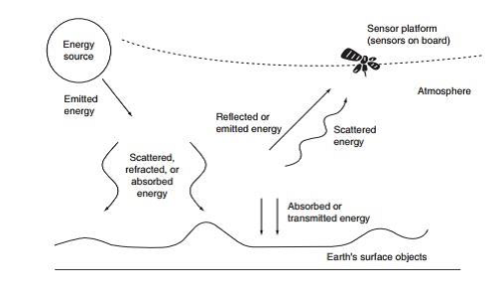Table of Contents
Remote Sensing
Remote sensing is the technique of acquiring information about an object without actually being in contact with it (Jorgensen & Fath, 2008). However, more often remote sensing is understood as the capturing information from a distance (rather than in situ) about the Earth’s terrestrial and aquatic ecosystems and atmosphere, by sampling reflected and emitted radiation (Kitchin & Thrift, 2008).
Definition
Jensen (2007) defines remote sensing as:
„the non-contact recording of information from the ultraviolet, visible, infrared, and microwave regions of the electromagnetic spectrum by means of instruments such as cameras, scanners, lasers, linear arrays, and/or area arrays on platforms such as aircraft or spacecraft, and the analysis of acquired information by means of visual and digital image processing“.
The results of remote sensing are images with an abundance of information allowing us to “determine the composition and nature of the Earth’s surface and atmosphere from local to global scales” (Kitchin & Thrift, 2008). Through the repetitive nature of the remote sensing, these images hold information about changes at different points in time and are thus good proxys for ecosystem services, see indicators. Thus remote sensing is a powerful tool to assess information that would otherwise be difficult to obtain within the same scale of time and space. Consequently, remote sensing becomes “a multi-faceted, multi-disciplinary endeavour to acquire information from targets” (Clark & Rilee, 2010).
Basic Principles
The foundation of remote sensing lies within the measurement of reflected and emitted electromagnetic radiation from the Earth’s surface and this radiation is measured and categorized as a function of its wavelength on a logarithmic scale (Jorgensen & Fath, 2008). Remote sensing uses the physical principle of radiation to determine characteristics of surface depending on the emitted or reflected wavelength (Kitchin & Thrift, 2008). These wavelengths are in the following categories: Ultraviolet, Visible, meaning visible to the human eye (VIR). In near-Infrared (NIR), where reflected radiance is measured. In the mid-infrared, where reflected and emitted radiance can be measured and in the far-infrared, where only emitted energy is measured in the form of thermal energy, here referred to as TIR (Clark & Rilee, 2010). The advantage of multispectral remote sensing is related to the different types of materials which can be distinguished on the basis of differences in their spectral signatures (Schowengerdt, 2007). The remote sensors are categorized into active and passive sensors. Active sensors generate their own signal which is sent to the Earth’s surface and the reflection is measured, e.g. RADAR or LIDAR. Passive sensors measure emittance and reflection from the Earth’s surface of solar energy (Kitchin & Thrift, 2008).
Basic components
<font 9px/inherit;;inherit;;inherit>A typical remote-sensing system. Components and Energy Pathways (from Clark & Rilee, 2010)</font>
The basic components of a remote sensing systems are
- an energy/light source
- an energy sink (Earth’s surface objects)
- and a sensor platform capturing the reflected and emitted radiance onto a recording medium (Schowengerdt, 2007).
With respect to analog arial photography where a lens is focusing the light on photographic film, digital sensors record photons for a specific range of wavelength (Kitchin & Thrift, 2008), and these are stored as digital numbers representing brightness values as an array of pixels.
Characteristics
Several characteristics distinguish the qualities and detail of a remotely sensed image, traditionally referred to as the four types of resolution (Jensen, 2007):
- Spatial resolution, which defines the size of the pixel (smallest discrete picture element) if it were projected onto the earth’s surface.
- Spectral resolution refers to the range or bandwidth of wavelength that are detected in an image. This also refers to band placement, which defines the portion of electromagnetic wavelength captured for a specific domain, for example 9.5 TIR.
- Radiometric resolution refers to the bandwidth of potential brightness values that can be stored in a pixel. Sensors with higher radiometric resolution capture more distinct differences in the brightness values, as opposed to lower radiometric resolution.
- Temporal resolution defines the repeat frequency, which is how frequently a sensor takes image of the same location. Another element of the temporal resolution is the date of the acquisition, it refers to timing issues in order to remotely monitor effects or ecological events, e.g. floods.
Clark, P. E., & Rilee, M. L. (2010). Remote sensing tools for exploration: Observing and interpreting the electromagnetic spectrum. New York: Springer.
Kitchin, R., & Thrift, N. J. (2008). International encyclopedia of human geography. Amsterdam: Elsevier.
Jensen, J. R. (2007). Remote sensing of the environment: An earth resource perspective (2nd ed). Prentice Hall series in geographic information science. Upper Saddle River, NJ: Pearson Prentice Hall.
Jorgensen, S. E., & Fath, B. (2008). Encyclopedia of Ecology, Five-Volume Set. Oxford: Elsevier Science.
Schowengerdt, R. A. (2007). Remote sensing: Models and methods for image processing (3rd ed). Burlington, MA: Academic Press.
